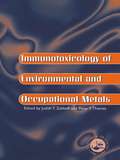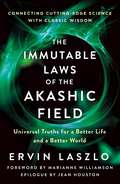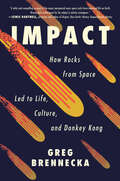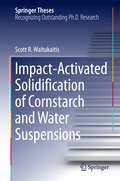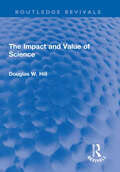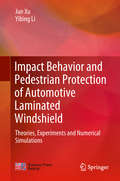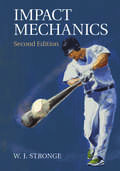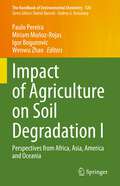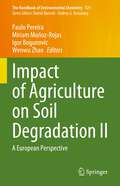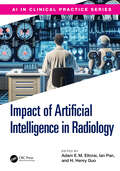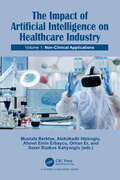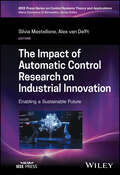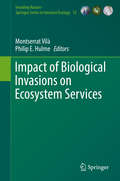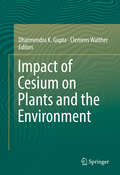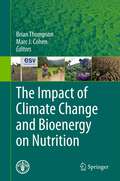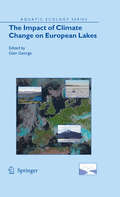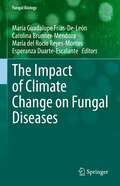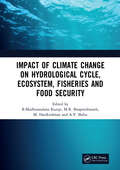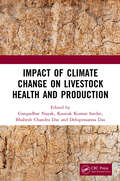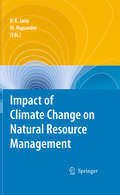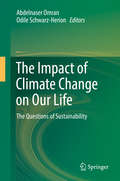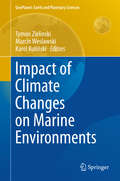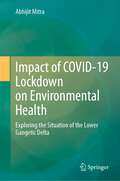- Table View
- List View
Immunotoxicology Of Environmental And Occupational Metals
by Judith T. Zelikoff Peter T. ThomasProvides an overview of the effects of environmentally and occupationally important metals on the immune system and host defence. The fist ten chapters in the text focus on particular metals or groups of metals, including arsenic, beryllium, cadmium, chromium, lead, mercury, nickel and vanadium. Subsequent chapters examine the immunotoxicological e
The Immutable Laws of the Akashic Field: Universal Truths for a Better Life and a Better World
by Ervin LaszloConnecting Cutting-Edge Science with Classical WisdomThe Akashic Field is a cosmic field in which all information and knowledge is interconnected and preserved. Our very reality is anchored in this vast sea of connected information that gives rise to everything—from specks of stardust in the outer cosmos to consciousness itself. In The Immutable Laws of the Akashic Field, Dr. Ervin Laszlo, renowned authority in the fields of new science, consciousness, and spirituality, has written an accessible introduction to the mysteries of the Akashic Field, explaining how leading science supports this ancient intuition of the deep reality of the universe. The Immutable Laws of the Akashic Field also features contributions from other leading voices, including Dr. Maria Sagi, Christopher M. Bache, and Kingsley L. Dennis along with a foreword by Marianne Williamson. This approachable text offers a brilliant introduction to and bold affirmation of one of the most profound wonders of our universe.
Impact: How Rocks from Space Led to Life, Culture, and Donkey Kong
by Greg BrenneckaA Short History of Nearly Everything meets Astrophysics for People in a Hurry in this humorous, accessible exploration of how meteorites have helped not only build our planet but steered the evolution of life and human culture.The Solar System. Dinosaurs. Donkey Kong. What is the missing link? Surprisingly enough, it's meteorites. They explain our past, constructed our present, and could define our future.Impact argues that Earth would be a lifeless, inhospitable piece of rock without being fortuitously assaulted with meteorites throughout the history of the planet. These bombardments transformed Earth’s early atmosphere and delivered the complex organic molecules that allowed life to develop on our planet. While meteorites have provided the raw materials for life to thrive, they have radically devastated life as well, most famously killing off the dinosaurs and paving the way for humans to evolve to where we are today.As noted meteoriticist Greg Brennecka explains, meteorites did not just set us on the path to becoming human, they helped direct the development of human culture. Meteorites have influenced humanity since the start of civilization. Over the centuries, meteorite falls and other cosmic cinema have started (and stopped) wars, terrified millions, and inspired religions throughout the world. With humor and an infectious enthusiasm, Brennecka reveals previously untold but important stories sure to delight and inform readers about the most important rocks on Earth.
Impact!: Asteroids and the Science of Saving the World
by Elizabeth Rusch Karin AndersonAsteroids bombard our atmosphere all the time. Some are harmless, burning up in a flash of light. But others explode with a great sonic boom, smashing windows and throwing people to the ground. Worst of all, some asteroids strike our planet, blasting out massive craters and destroying everything nearby on impact. Follow the award-winning author Elizabeth Rusch into the field with scientists as they search for dangerous asteroids in space, study asteroids that have smashed into the ground, and make plans to prevent an asteroid strike if one ever threatens our planet.
Impact-Activated Solidification of Cornstarch and Water Suspensions
by Scott R. WaitukaitisThis thesis approaches impact resistance in dense suspensions from a new perspective. The most well-known example of dense suspensions, a mixture of cornstarch and water, provides enough impact resistance to allow a person to run across its surface. In the past, this phenomenon had been linked to "shear thickening" under a steady shear state attributed to hydrodynamic interactions or granular dilation. However, neither explanation accounted for the stress scales required for a person to run on the surface. Through this research, it was discovered that the impact resistance is due to local compression of the particle matrix. This compression forces the suspension across the jamming transition and precipitates a rapidly growing solid mass. This growing solid, as a result, absorbs the impact energy. This is the first observation of such jamming front, linking nonlinear suspension dynamics in a new way to the jamming phase transition known from dry granular materials.
The Impact and Value of Science (Routledge Revivals)
by Douglas W. HillFirst published in 1945, The Impact and Value of Science is both a plea and a challenge: a plea for more and more science – not to increase the sum total of technical knowledge nor to extend present material amenities, but in the words of the author for the sake of "mental maturity." It is a challenge to try the method of science. Every man is a scientist and every scientist a useful citizen. Dr. Hill has been both an industrial and academic scientist but here he is concerned with something much wider than textbook conception of science. He gives a clear answer to those who argue that scientific progress is leading to man’s destruction by showing that if the scientific method is applied in "non-scientific" fields – in religion, ethics, politics – man will learn how to use the technical inventions of science as stepping stones in social and economic progress. With space tourism and climate crisis marking the two ends of scientific development in current times, this book is of value to everyone but especially to students of climate change, public policy and ethics.
Impact Behavior and Pedestrian Protection of Automotive Laminated Windshield: Theories, Experiments And Numerical Simulations
by Jun Xu Yibing LiThis book addresses one of the most important components for pedestrian safety in vehicles – laminated windshields. It includes detailed real-world material characterization results for laminated glass and testing methodologies, constitutive models, and step-by-step numerical simulation modeling and simulation methods. As such, the book provides readers a thorough understanding of the mechanical behaviors of laminated glass and windshields. It also presents fundamental test data, analysis methodologies and essential insights into laminated glass safety design and mechanical behavior prediction. The book addresses the needs of researchers, engineers and postgraduate students in the fields of automotive engineering, mechanical engineering and related areas.
Impact Mechanics
by W. J. StrongeEmphasising non-penetrating collisions, the second edition of Impact Mechanics develops several different methodologies for analysing collisions between structures - from rigid body theory for structures that are stiff and compact, to vibration and wave analyses for flexible structures. A valuable reference for both professionals and advanced undergraduate and graduate students, the book builds upon foundation courses in dynamics and strength of materials. Worked examples and end-of-chapter homework problems are drawn both from industry and sports such as golf, baseball, soccer and billiards. New chapters present a generalised theory of multi-body impact, as well as analyses of visco-elastic and visco-plastic impact. Effects of local compliance on impact dynamics are more generally described, and additional examples illustrating effects of friction during impact between bodies in either collinear or eccentric configurations are included.
Impact of Agriculture on Soil Degradation I: Perspectives from Africa, Asia, America and Oceania (The Handbook of Environmental Chemistry #120)
by Paulo Pereira Miriam Muñoz-Rojas Igor Bogunovic Wenwu ZhaoThis is the first of two volumes that together provide a global overview of the impact of agriculture on soil degradation, tracing the most critical drivers like the use and abuse of agrochemicals, mechanization, overgrazing, irrigation, slash and burn agriculture, and the use of plastics. This book covers the main effects of agriculture practices on soil degradation in several countries from Africa, America, Asia, and Oceania, and it elucidates the impact of chemical agents on soil quality, namely, the use of fertilizers, herbicides, pesticides, soil acidification and microplastics pollution. In these continents, a large number of the population depend on agriculture, which sets an enormous pressure on the ecosystems. Divided into 13 chapters, the book offers authoritative contributions about the fundamental soil degradation problems in countries such as Argentina, Australia, Peru and Bolivia, Brazil, Chile, China, Colombia, India, Israel, Kenya, Mexico, South Africa, the United States of America. As soil degradation issues are often linked with biodiversity loss and poverty, readers will also find in this book an important discussion of the different social, economic, political, and environmental aspects contributing to soil quality and sustainable management. Given the breadth and depth of its coverage, the book offers an invaluable source of information for researchers, students, environmental managers and policymakers alike.
Impact of Agriculture on Soil Degradation II: A European Perspective (The Handbook of Environmental Chemistry #121)
by Paulo Pereira Miriam Muñoz-Rojas Igor Bogunovic Wenwu ZhaoThis is the second of two volumes that together provide a global overview of the impact of agriculture on soil degradation, tracing the most critical drivers like the use and abuse of agrochemicals, mechanization, overgrazing, irrigation, slash and burn agriculture, and the use of plastics.Soil degradation caused by agriculture practices is a complex issue which depends on the interaction of social, economic, political, and environmental aspects. In this book, expert contributors elucidate the extension of the effects of agriculture on soil degradation in Europe, a continent with different cultures and political backgrounds that affect agricultural practices. Readers will also find in this book authoritative solutions to minimize the effects of agriculture intensification and land-use in this continent. Divided into 12 chapters, the book offers a European perspective on soil quality and sustainable management, including case studies about the impact of chemical agents like fertilizers, herbicides, pesticides, and soil acidification and microplastics pollution in agriculture practices from countries such as Croatia, Czech Republic, Estonia, Latvia and Lithuania, Germany, Portugal and Greece, Hungary, Iceland, Italy, Slovenia, Spain, Sweden, and Ukraine. Given the breadth and depth of its coverage, the book offers an invaluable source of information for researchers, students and environmental managers alike.
The Impact of Artificial Intelligence in Radiology (AI in Clinical Practice)
by Adam E. M. Eltorai, Ian Pan, and H. Henry GuoImplementation of artificial intelligence (AI) in radiology is an important topic of discussion. Advances in AI—which encompass machine learning, artificial neural networks, and deep learning—are increasingly being applied to diagnostic imaging. While some posit radiologists are irreplaceable, certain AI proponents have proposed to "stop training radiologists now." By compiling perspectives from experts from various backgrounds, this book explores the current state of AI efforts in radiology along with the clinical, financial, technological, and societal perspectives on the role and expected impact of AI in radiology.
The Impact of Artificial Intelligence on Healthcare Industry: Volume 1: Non-Clinical Applications
by Mustafa Berktas Abdulkadir Hiziroglu Ahmet Emin Erbaycu Orhan Er Sezer Bozkus KahyaogluHealthcare and medical science are inherently dependent on technological advances and innovations for improved care. In recent times we have witnessed a new drive in implementing these advances and innovations through the use of Artificial Intelligence, in both clinical and non-clinical areas.The set of 2 volumes aims to make available the latest research and applications to all, and to present the current state of clinical and non-clinical applications in the health sector and areas open to development, as well as to provide recommendations to policymakers. This volume covers non-clinical applications. The chapters covered in this book have been written by professionals who are experts in the healthcare sector and have academic experience.
The Impact of Automatic Control Research on Industrial Innovation: Enabling a Sustainable Future (IEEE Press Series on Control Systems Theory and Applications)
by Silvia Mastellone Alex Van DelftThe Impact of Automatic Control Research on Industrial Innovation Bring together the theory and practice of control research with this innovative overview Automatic control research focuses on subjects pertaining to the theory and practice of automation science and technology subjects such as industrial automation, robotics, and human???machine interaction. With each passing year, these subjects become more relevant to researchers, policymakers, industrialists, and workers alike. The work of academic control researchers, however, is often distant from the perspectives of industry practitioners, creating the potential for insights to be lost on both sides. The Impact of Automatic Control Research on Industrial Innovation seeks to close this distance, providing an industrial perspective on the future of control research. It seeks to outline the possible and ongoing impacts of automatic control technologies across a range of industries, enabling readers to understand the connection between theory and practice. The result is a book that combines scholarly and practical understandings of industrial innovations and their possible role in building a sustainable world. The Impact of Automatic Control Research on Industrial Innovation readers will also find: Insights on industrial and commercial applications of automatic control theory. Detailed discussion of industrial sectors including power, automotive, production processes, and more. An applied research roadmap for each sector. This book is a must-own for both control researchers and control engineers, in both theoretical and applied contexts, as well as for graduate or continuing education courses on control theory and practice.
The Impact of Binary Stars on Stellar Evolution (Cambridge Astrophysics #54)
by Giacomo Beccari Henri M. BoffinStars are mostly found in binary and multiple systems, with at least 50% of all solar-like stars having companions; this fraction approaches 100% for the most massive stars. A large proportion of these systems interact and alter the structure and evolution of their components, leading to exotic objects such as Algol variables, blue stragglers and other chemically peculiar stars, but also to phenomena such as non-spherical planetary nebulae, supernovae and gamma-ray bursts. While it is understood that binaries play a critical role in the Initial Mass Function, the interactions among binary systems significantly affect the dynamical evolution of stellar clusters and galaxies. This interdisciplinary volume presents results from state-of-the-art models and observations aimed at studying the impact of binaries on stellar evolution in resolved and unresolved populations. Serving as a bridge between observational and theoretical astronomy, it is a comprehensive review for researchers and advanced students of astrophysics.
Impact of Biological Invasions on Ecosystem Services
by Montserrat Vilà Philip E. HulmeThe book presents an analysis of the ecological, economic and social threats posed by the introduction and spread of non-native species. It provides a comprehensive description of impacts of non-native species from all five kingdoms of life across all ecosystems of the world. New insights into the impacts arising from biological invasions are generated through taking an ecosystem services perspective. This work highlights that management of biological invasions is needed not only to sustain biodiversity and the environment, but also to safeguard productive sectors such as agriculture, forestry and fisheries, as well as to preserve human health and well-being.
Impact of Cesium on Plants and the Environment
by Dharmendra K. Gupta Clemens WaltherThis book provides extensive and comprehensive knowledge to the researchers/academics who are working in the field of cesium contaminated sites, and the impact on plants. This book is also helpful for graduate and undergraduate students who are specializing in radioecology or safe disposal of radioactive waste, remediation of legacies and the impact on the environment. Radiocesium (137Cs and 134Cs) was released into the environment as a result of nuclear weapons testing in 1950s and 1960s (~1x1018 Bq), and later due to the Chernobyl accident in 1986 (8. 5x1016 Bq) and Fukushima Daiichi Nuclear Power Plant in 2011 (~1x1017 Bq). 137Cs is still of relevance due to its half-life of 30 years. The study of radioisotope 137Cs is important, as production and emission rates are high compared to other radioisotopes, due to high fission yield and high volatility. This book contains original work and reviews on how cesium is released into the environment on translocation from soil to plants and further on to animals and into the human food chain. Separate chapters focus on the effective half-life of cesium in plants and on how different cultivars are responding in accumulation of cesium. Other key chapters focus on cesium impact on single cells to higher plants and also on remediation measures as well as on basic mechanism used for remedial options and analysis of transfer factors. The book rounds off by contributions on cesium uptake and translocation and its toxicity in plants after the Chernobyl and Fukushima accidents.
The Impact of Climate Change and Bioenergy on Nutrition
by Marc J Cohen Brian ThompsonClimate changes will affect food production in a number of ways. Crop yields, aquatic populations and forest productivity will decline, invasive insect and plant species will proliferate and desertification, soil salinization and water stress will increase. Each of these impacts will decrease food and nutrition security, primarily by reducing access to and availability of food, and also by increasing the risk of infectious disease. Although increased biofuel demand has the potential to increase incomes among producers, it can also negatively affect food and nutrition security. Land used for cultivating food crops may be diverted to biofuel production, creating food shortages and raising prices. Accelerations in unregulated or poorly regulated foreign direct investment, deforestation and unsustainable use of chemical fertilizers may also result. Biofuel production may reduce women's control of resources, which may in turn reduce the quality of household diets. Each of these effects increases risk of poor food and nutrition security, either through decreased physical availability of food, decreased purchasing power, or increased risk of disease. The Impact of Climate Change and Bioenergy on Nutrition articulates the links between current environmental issues and food and nutrition security. It provides a unique collection of nutrition statistics, climate change projections, biofuel scenarios and food security information under one cover which will be of interest to policymakers, academia, agronomists, food and nutrition security planners, programme implementers, health workers and all those concerned about the current challenges of climate change, energy production, hunger and malnutrition.
The Impact of Climate Change on European Lakes
by Glen GeorgeIn this book, scientists from eleven countries summarize the results of an EU project (CLIME) that explored the effects of observed and projected changes in the climate on the dynamics of lakes in Northern, Western and Central Europe. Historical measurements from eighteen sites were used to compare the seasonal dynamics of the lakes and to assess their sensitivity to local, regional and global-scale changes in the weather. Simulations using a common set of water quality models, perturbed by six climate-change scenarios, were then used to assess the uncertainties associated with the projected changes in the climate. The book includes chapters on the phenology and modelling of lake ice, the supply and recycling of nitrogen and phosphorus, the flux of dissolved organic carbon and the growth and the seasonal succession of phytoplankton. There are also chapters on the coherent responses of lakes to changes in the circulation of the atmosphere, the development of a web-based Decision Support System and the implications of climate change for the Water Framework Directive.
The Impact of Climate Change on Fungal Diseases (Fungal Biology)
by María Guadalupe Frías-De-León Carolina Brunner-Mendoza María del Rocío Reyes-Montes Esperanza Duarte-EscalanteThe shift of weather patterns has affected the incidence and prevalence of infectious diseases, including mycoses. Mycoses have remained neglected due to a lack of training and recognition within the medical community. Nonetheless, these diseases remain common worldwide while frequently being underdiagnosed. Climate change affects the distribution of fungal communities, provoking outbreaks in locations where these mycoses were absent or in low frequencies. Moreover, the reports of clinical cases related to new fungal pathogens have increased due to the description of new fungal species or due to the ability of some species to shift to new hosts. Thus, this book, The Impact of Climate Change on Fungal Diseases, is a contribution to the knowledge of a global environmental phenomenon and its relation to these diseases, and it serves as a guide for health professionals to dive deep into the repercussions of climate change and how they can implement measures for the prevention and control of fungal infections.
Impact of Climate Change on Hydrological Cycle, Ecosystem, Fisheries and Food Security
by B. Madhusoodana KurupClimate change has emerged as the most pressing global challenge of the 21st century and it has a dramatic effect on natural ecosystems and environment. Intelligent mitigation strategies to minimise climate change impacts can result in advanced, novel technologies; healthier aquatic ecosystems and higher food security and well-being for humans. The book includes 45 Chapters by expert authors, covering (i) Hydrometeorology and hydrology, (ii) Natural hazards and disaster risk management, (iii) Aquaculture, (iv) Changing biodiversity scenarios, (v) Capture fisheries, (vi) Food and nutritional insecurity, (vii) Climate change and socio-economic scenarios, and allied areas. It is hoped that this volume will further our understanding and research achievements in the field of climate change and its consequences and facilitate the synthesis of information on how climate-related changes will influence oceans, marine and inland ecosystems, hydrological cycles, fisheries and aquaculture and coastal communities and will be immensely useful to planners, scientists, conservationists, environmentalists, academicians, students and all those who are directly or indirectly involved in the study of impact of climate change and mitigation measures Note: T& F does not sell or distribute the Hardback in India, Pakistan, Nepal, Bhutan, Bangladesh and Sri Lanka.
Impact of Climate Change on Livestock Health and Production
by G D Nayak K K Sardar B C Das D P DasThis volume of 30 chapters contributed by reputed authors covers: Diversification of livestock and crops. Integration of livestock systems with forestry and crop production. Drought and heat wave tolerant varieties. Strategies for reduction of Green House Gases emission from ruminants. Application of GIS and remote sensing technologies. Breeds with inherent genetic capabilities to adapt to climate change. This book also takes into account the climate change adaptation, mitigation practices, and policy frameworks for promotion of sustainable livestock and poultry production. This book is co-published with NIPA. Taylor and Francis does not sell or distribute its print and electronic editions in India, Pakistan, Nepal, Bhutan, Bangladesh and Sri Lanka.
Impact of Climate Change on Natural Resource Management
by Bipal Kr. Jana Mrinmoy MajumderAs climate change takes hold, there is an ever-growing need to develop and apply strategies that optimize the use of natural resources, both on land and in water. This book covers a huge range of strategies that can be applied to various sectors, from forests to flood control. Its aim, as with resource management itself, is to combine economics, policy and science to help rehabilitate and preserve our natural resources. Beginning with papers on carbon sequestration, including the practice of artificial desertification, the topics move on to cover the use of distributed modeling and neural networks in estimating water availability and distribution. Further chapters look at uncertainty analysis applied to the spatial variation of hydrologic resources, and finally the book covers attempts at estimating meteorological parameters in the context of hydrological variables such as evapo-transpiration from stream flow. Within the next decade, the effects of climate change will be severe, and felt by ordinary human beings. This book proposes a raft of measures that can mitigate, if not reverse, the impact of global warming on the resources we have all come to depend on.
The Impact of Climate Change on Our Life: The Questions Of Sustainability
by Abdelnaser Omran Odile Schwarz-HerionThis book introduces the highly topical issue from many different angles, sensitizing readers to the various challenges to human life posed by climate change, identifying possible intentional and inadvertent anthropogenic factors and consequences, and seeking socially and environmentally viable solutions. The book begins by examining the impact of the climate change discussion on science, politics, economy and culture – from its historical origin in the first Club of Rome Report and its inclusion in the UN's SDGs to the Paris Agreement and beyond. Comprising 12 chapters, it analyses the factors which caused the catastrophic 2014 Kelantan flood in Malaysia, focusing on the Kuala Krai district and discusses mud architecture in Wadi Hadramout, Yemen and mitigating the expected effects of climate change on this unique architecture and cultural heritage. It also examines the economic costs of climate change on health and the increased burden on individual expenditures and national health systems. The role of climate change in the water-energy nexus and efforts to increase efficiency in energy and water end-use to increase Queensland’s agricultural sector’s resilience in Australia is addressed, as is water security and climate change issues in developing countries and the potential of partnership procurement strategies for managing sustainable urban water supply in Nigerian cities. It also includes a chapter offering a new approach to waste management, exploring to what extent waste can complicate our daily actions and influence environmental decay, and recommending that renewable materials be sorted and separated from other types of materials to avoid cross-contamination, to increase the value of the materials, and to ease the process of manufacturing. Subsequent chapters identify factors sustaining the municipal solid waste management and practices in Ajdabiya city in Libya, and look at accounting disclosure remedies by exploring areas in which sustainability reporting could expand beyond corporate environmental reporting to additional disclosures, curbing recklessness in pursuing merely economic goals. The book shows – from the perspective of agriculture – how human activities can increase the negative impacts of climate change on lifestyle in Malaysia, suggesting alternative lifestyles and encouraging international cooperative efforts. The last chapters evaluate the impacts of various environmental factors on the local tourism sector in Pakistan, and discuss strategies to tackle climate change, focusing on the opportunities and risks of climate engineering. Since these risks encompass inadvertent negative effects and targeted abuse for covert weather warfare and terrorism that violate the UN’s ENMOD convention, the author recommends viable alternatives to deal with climate change.
Impact of Climate Changes on Marine Environments
by Tymon Zielinski Marcin Weslawski Karol KulińskiThis book contributes to the current discussion on global environmental changes by discussing modifications in marine ecosystems related to global climate changes. In marine ecosystems, rising atmospheric CO2 and climate changes are associated with shifts in temperature, circulation, stratification, nutrient input, oxygen concentration and ocean acidification, which have significant biological effects on a regional and global scale. Knowing how these changes affect the distribution and abundance of plankton in the ocean currents is crucial to our understanding of how climate change impacts the marine environment. Ocean temperatures, weather and climatic changes greatly influence the amount and location of nutrients in the water column. If temperatures and currents change, the plankton production cycle may not coincide with the reproduction cycle of fish. The above changes are closely related to the changes in radiative forcing, which initiate feedback mechanisms like changes in surface temperature, circulation, and atmospheric chemistry.
Impact of COVID-19 Lockdown on Environmental Health: Exploring the Situation of the Lower Gangetic Delta
by Abhijit MitraThis book examines the impacts that the COVID-19 lockdown has had on environmental and ecological health, with a focus on coastal ecosystems in the Lower Gangetic Delta. The book begins with an overview of COVID-19's spread and impact before and after the lockdown in the focus region, then addresses the specific impacts that the lockdown period had and continues to have on air quality, marine and estuarine water quality, coastal biodiversity, and the livelihoods of the region's inhabitants, especially those who live below the poverty line. The decrease in human activity combined with the complete closure of various sectors, including air travel, oil and gas drilling, and construction, has had a pronounced effect on biodiversity and overall environmental health that is yet to be fully realized. The book sheds light on these changes and assesses how biodiversity, ambient air quality, and ecosystem functioning will progress as COVID-19 remains a threat and the lockdown persists. The study will be of interest to researchers, government officials and professionals dealing with disaster management, environmental science, biological science, and health.
